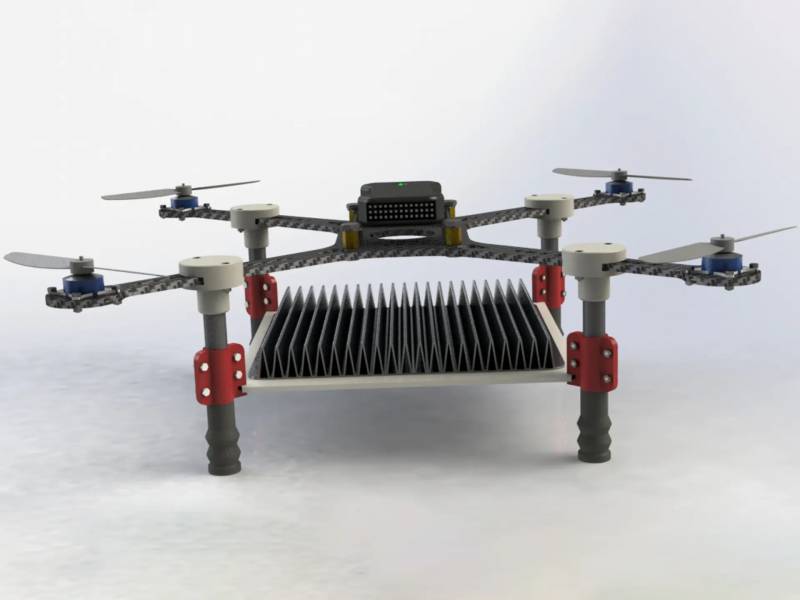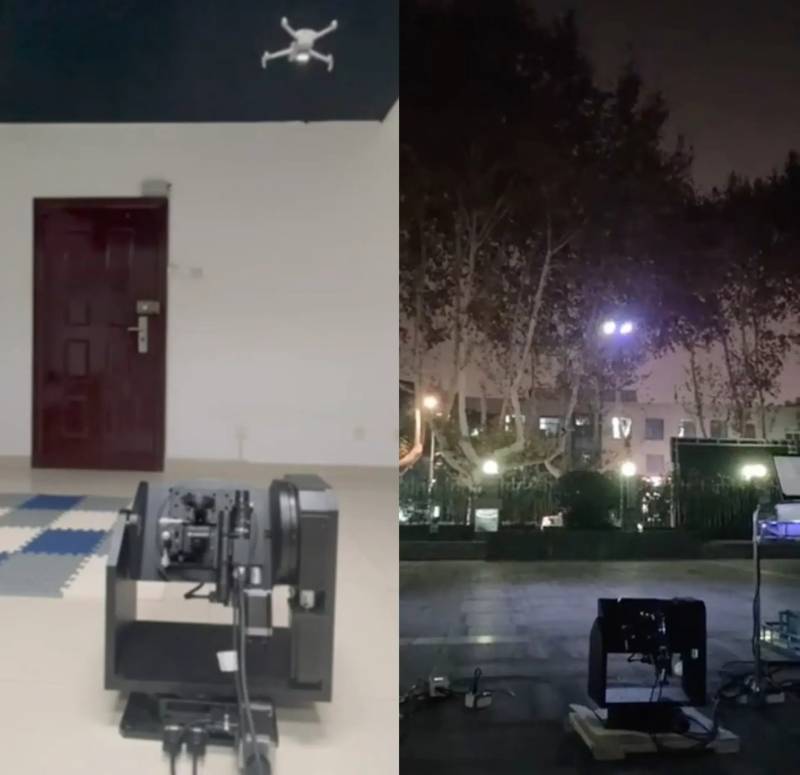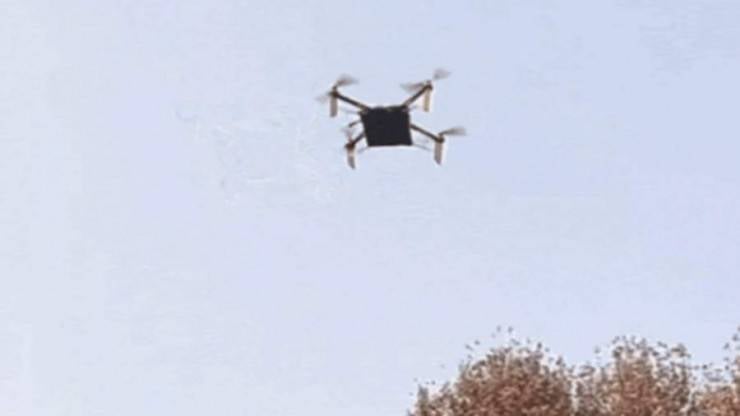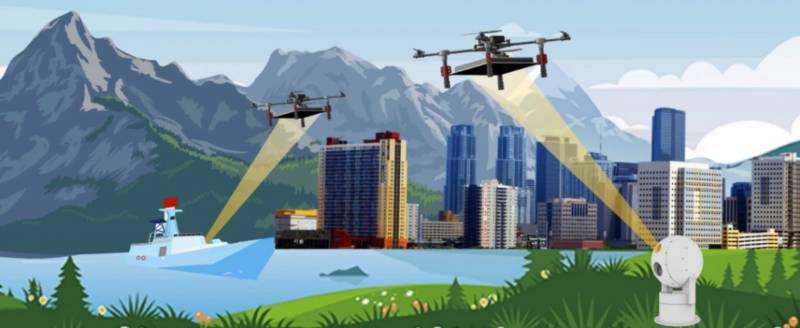Energy by Laser: Power Supply Project for Copter by Chinese Engineers

Experienced UAV with a solar panel
Helicopter-type unmanned aerial vehicles have a number of characteristic advantages, due to which they have become widespread. At the same time, there are also disadvantages, the main of which is the limited duration and range of flight. Various methods are proposed to increase these parameters, and another interesting development of this kind was presented by specialists from the Chinese Northwestern Polytechnic University.
Drone and laser
Several Chinese publications wrote about the new development of Chinese scientists in early January. Reportedly, the author of the project is Professor Li Xuelong and his colleagues in SZPU. They recently designed and developed an original concept drone for a long flight. These ideas were then tested with experimental techniques.
The main idea of the project is a radical restructuring of the UAV power system. A conventional electric quadcopter equipped with a battery has to be returned and landed to recharge or replace the battery. Li Xuelong and his colleagues propose to keep the battery on board the drone, as well as equip it with a low-mass solar panel. At the same time, the ground part is being introduced into the complex, which includes units responsible for generating electricity. In addition, means have been developed for transmitting energy to the UAV.
It is noted that high-power lasers are so far only used to combat drones. However, the project from SZPU proposes to use a laser beam to transfer energy from the ground part of the complex to the UAV. The automation of the complex should monitor the drone and direct the beam exactly at its solar panel, ensuring a constant power supply and recharging the battery.
SZPU specialists have developed all the components of the complex, including special software responsible for tracking the UAV and pointing the laser. With the help of these products, several tests have already been carried out in different conditions. The drone was powered and flew indoors as well as outdoors day and night. The maximum flight duration reached 24 hours.

Ground facilities for testing at different times of the day
It should be noted that systems for laser energy transfer to UAVs have already been developed abroad. However, then aircraft-type drones were used, and projects did not move beyond calculations or experiments in a wind tunnel and in the air.
Elements of the complex
According to published data, an experimental unmanned complex from SZPU includes several fixed assets. This is a ground-based power generation and transmission system, an operator console and the drone itself. The general principles of operation are known, but details are not reported. The main characteristics of the complex are also not disclosed - both for copy protection and to avoid the use of technology for military purposes.
In the experiments, a small-sized quadrocopter with electric motors is used. Probably, they took a ready-made UAV available on the market for experiments. As the project proposes, in addition to the battery, he received a solar panel and related devices. The square device is suspended under the body.
Apparently, the UAV electronics have not changed, as well as the operator's console. From the prototype, only the ability to follow the instructions of the operator or independently fly and hang is required. However, new functions related to interaction with the power supply system could be added.
Of greatest interest are the ground facilities of the complex. They include a power supply system - from the mains or from a generator. There is also an optical-electronic station with cameras and a laser of the required power. The operation of ground facilities is controlled by an autonomous digital system with special software.
It is reported that the IES of the complex is able to take the UAV for escort and track all its movements within the visibility zone. The computer is responsible for tracking; the operator can focus on the main task. When the battery needs to be recharged, the control system automatically directs the laser beam at the solar panel and holds it.

UAV in the air
The control system determines the range to the drone and monitors other factors. Taking them into account, automation changes the power and focusing of the beam. Due to this, a constant supply of the same power is ensured, regardless of the mutual position of the UAV and the ECO, external conditions, etc. When an obstacle is detected in the path of the beam, the power is reduced to a safe value.
Desired benefits
The principles of operation of such a complex are quite simple. After "normal" charging, the UAV can take off and perform its assigned tasks. Having worked out most of the battery charge, the drone must return to the charging zone, where the ECO will find it and begin to “highlight” it with a laser. Having received energy and recharging the battery, the UAV will be able to continue working in the air. Such a cycle can be repeated several times in a row, depending on the characteristics of the mission and current needs.
A complex with such capabilities has obvious advantages. First of all, this is a sharp increase in the possible duration of the flight and the ability to do without landings. The drone does not have to return to the ground to recharge or change the battery. In some situations, he will be able to charge from the laser without even leaving the work area and continuing to work.
An unmanned complex with such capabilities should perform the tasks of long-term surveillance and reconnaissance. At the same time, the UAV will be able to operate at some distance from ground facilities, allowing it to return in time for recharging. The developers assume that the complex will be useful in monitoring various situations, during search and rescue operations, etc.
In the future, the creation of large UAVs with laser power supply is not excluded. Based on them, a full-size air transport network can be built. However, a large drone will require appropriate ground infrastructure.
It should be noted that the proposed SZPU power supply system is not without drawbacks that make it difficult to develop and deploy, and also impose restrictions on operation. Some of the difficulties were dealt with at the development stage, and new successes can be expected. However, getting rid of all problems is not yet guaranteed.

The work of laser power supply in the representation of the artist
Almost all the difficulties are connected with the chosen principle of energy transfer. It requires accurate UAV tracking and laser guidance, which requires fairly complex hardware and software systems. In addition, the laser beam is not very efficient, and this figure can be further reduced due to external factors.
It should also be taken into account that the appropriate beam power is needed to quickly charge the battery. With careless handling, the ground-based OES actually stops in a combat laser complex and can cause damage to surrounding objects or even to the drone itself. Thus, a laser can irreversibly damage the optics of a reconnaissance aircraft.
The developers of the project from SZPU claim that they managed to create control equipment with the necessary functions. An experienced UAV in different conditions flew around ground facilities and climbed to a height of tens of meters. It is reported that in all cases sufficient energy was transmitted, and the environment did not receive any damage.
So far, we are talking only about a small-sized UAV, and on this scale the complex has shown itself well. In the future, it is planned to develop the project and increase the drone, as well as increase the laser power. Whether the developed system is scalable or whether this process can lead to unsolvable problems is not yet clear. But the first experiments give cause for optimism.
Based on new principles
The vast majority of modern helicopter-type UAVs fly using batteries. If it is necessary to increase the range, the principle of tethered flight is used - a cable is pulled behind the drone, through which electricity is supplied from the ground. The duration of such a flight is limited only by the power supply, but the tethered copter cannot fly freely.
The new Chinese project implements another way to increase flight duration - through a special principle of energy transfer. The operability of the concept is already being tested using an experienced UAV and other equipment. Whether SZPU specialists will be able to solve all the tasks of the current stage and move on to the next one, time will tell.
Information